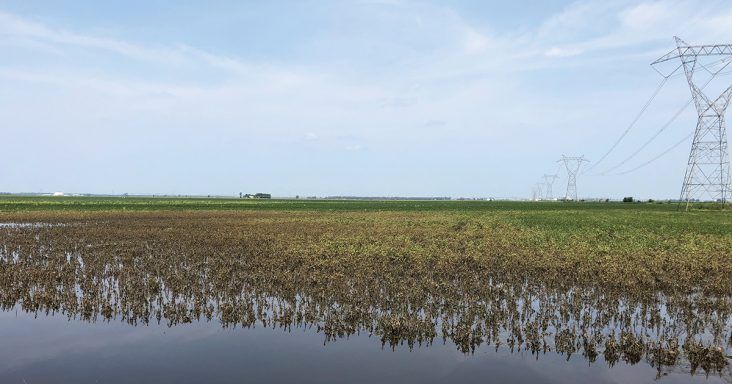Weeds, pests set to siege NEA farmers as floodwaters recede
by July 4, 2019 1:34 pm 476 views

Farmers in Arkansas are facing some of the worst conditions experienced in the sector in decades and new ones could emerge even as the floodwaters that have besieged many producers start to recede. Two major factors, weeds and pests, could become major problems as the growing season enters the summer months, according to the University of Arkansas System Division of Agriculture.
“The biggest issue with the rains and flooding is we’ve got late crops,” said UA extension entomologist and professor Gus Lorenz. “The problems associated with late crops definitely include insect pressure. That’s particularly true with soybeans — that’s the crop we’re furthest behind in. By planting late, it allows insects to build up numbers and the bulk of our soybeans are in that situation. The stinkbugs, bollworms, loopers and all the pests, the later you plant the more exposure you have.”
Flooding may not be the primary issue for the insect upsurge.
“I don’t think the flooding has anything to do with the weevil numbers. I think the reason we’re seeing so much activity so early is the mild winter we had,” he said. “There was a lot of overwintering survival of insects and that meant a larger number starting the growing season. Add in late-planted crops and we’re set up for a tough 2019. Producers don’t need the added expense of dealing with insects, but it looks like that’s where we’re headed.”
Soybeans
In the state’s soybean crop, there are high numbers in bollworm traps, and moth counts are high for this time of year, Lorenz said. The division started running traps in mid-May and the migratory pattern from the south was detected. Bollworms could be a problem in cotton and soybeans. Bollworm larvae has been found in some of the early-planted soybeans, he added.
Arkansas entomologists conducted surveys for red-banded stinkbugs early in the spring.
“We were finding adult red-banded stinkbugs in the state early. That told us they overwintered and survived in the south part of Arkansas. Look a little farther south in Louisiana and their red-banded numbers are already beginning to increase. I’m afraid that is bad news for our southern tier of Arkansas counties — Ashley, Chicot, Desha, and Drew.”
Rice
In Lorenz’ rice plots, and in phone calls he’s getting from producers and consultants, “rice water weevil adult activity is extremely high — much higher than average for this time for year — in much of the rice-growing region of the state. We’re at the stage in our crop where we’re going to flood, and we’re seeing a lot of movement of rice weevil adults moving in. The flood is what triggers them to come into the fields.”
Everyone with rice going to flood needs to check their crop for rice water weevil adults and scarring, he warned.
“In a lot of cases, 28 to 35 days after planting and you’re putting the flood on, Cruiser is gone,” Lorenz said. “So, you may have to consider making foliar applications for adults. The only problem is you’ve got a narrow window to make those applications. It has to be three to 10 days after the flood goes on to make the application for adults. The females come in and lay eggs and when the larvae hatch and drop into the water, it won’t do any good to make the application.”
Cotton
At least one crop in the state, cotton, has experienced lighter than normal insect activity, according to estimates. Thrips, or cotton insects, have not been as numerous.
“This has been one of the lightest thrips we’ve experienced in a long time,” Lorenz said. “In fact, in my career, I’ve never seen thrips as light, particularly in cotton planted in late April or the first of May. On the other hand, we have had some problems behind some cover crops and corn where there was a lot of crop debris left behind from the previous year. Slugs were bad in a lot of the state. A lot of that had to do with the moisture and cool weather. They caused some stand loss in some fields, particularly in cotton and soybeans.”
Getting into and out of rain-soaked fields has been a daunting challenge, he said. Conditions like this are nearly unprecedented for this period in the planting season, he added.
“There’s a lot of early-planted cotton that’s around nine- to 10-nodes and there’s some plant bug movement. We noticed early in the spring when we were sweeping weeds at the edge of fields the numbers of tarnished plant bug numbers appeared to be extremely high. That leads me to believe we’ll have to deal with plant bugs for the rest of the year.”
Weeds will likely be a major problem as the season unfolds, but Lorenz cautioned farmers to not start applying weed killers too early.
“I’d be very cautious about making applications too early. Even though it’s been a wet year, there are some secondary pests like aphids and spider mites we’re picking up in our samples. I’m getting calls on aphids building in some of the cotton — three-, four- and five-leaf — and you want to be really cautious not to flare aphids by making unnecessary applications.”
